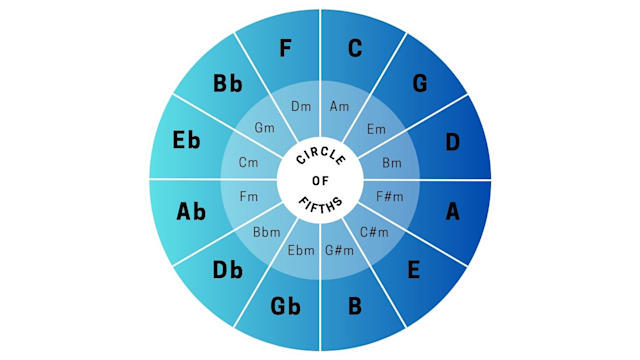Guide: Circle Of Fifths In Music Theory Explained
August 21, 2024 - Unlock the power of the circle of fifths to master key signatures, chord progressions, and harmonic sequences in music theory. Perfect for all musicians!

If you’ve ever wondered how musicians seem to effortlessly switch keys or create harmonic progressions that sound just right, then this article is for you.
The circle of fifths is a powerful visual tool that connects all 12 tones in Western music, helping you understand key signatures, chord progressions, and modulation. From C to G to D and beyond, it organizes pitches in a sequence of perfect fifths, unlocking a deeper understanding of music theory.
I think the circle of fifths is a core element of music that every musician should understand.
Imagine having a map that guides you through the complex landscape of major and minor scales, harmonies, and key changes. The circle of fifths doesn’t just make music theory easier; it makes it practical and applicable.
Whether you're a beginner or an experienced musician, using this tool can dramatically improve your ability to understand and create music.
Beyond just being an organizational chart, the circle of fifths also highlights the relationships between different keys. It shows how many sharps or flats are in each key signature and how these elements affect the sound and feel of the music.
The Basics of the Circle of Fifths
Understanding Major and Minor Keys
Major and minor keys form the backbone of Western music. Each key signature's placement in the Circle of Fifths reveals crucial relationships between different keys.
Major keys are shown by moving clockwise on the circle in intervals of perfect fifths.
Minor keys, typically a minor third below their relative major, are similarly organized.
The starting point, often the key of C major, has no sharps or flats. Each subsequent key adds one sharp as you move clockwise while moving counterclockwise adds one flat.
Navigating Major Scales and Chords
Each major key in the Circle of Fifths corresponds to a major scale, building a set of harmonious notes. The major scale follows a specific pattern of whole and half steps: W-W-H-W-W-W-H.
Let's look at the C major scale: it is comprised C-D-E-F-G-A-B. Major chords, built on these scales, consist of a root note, a major third, and a perfect fifth. That makes the C major chord C (Root), E (Major Third), and G (Perfect Fifth).
Learning each key's major scale and chord around the Circle of Fifths helps you understand their harmonic relationships and smooth modulations between keys.
Minor Scales and Chord Structures
Minor scales and chords provide contrast and depth in music. Each minor key is positioned directly inside the corresponding major key on the Circle of Fifths.
The natural minor scale follows a different pattern of whole and half steps: W-H-W-W-H-W-W.
Check out The A minor scale: It is comprised of A-B-C-D-E-F-G. Minor chords are built from the root note, a minor third, and a perfect fifth. The natural minor can be adjusted using harmonic or melodic minors for more variety. When looking at the A minor chord, it is made up of A (Root), C (Minor Third), and E (Perfect Fifth).
By mastering these scales and chords, you enhance your ability to create emotional and varied music compositions.

The Structure and Significance
Outer and Inner Circle Explained
The circle of fifths consists of an outer circle and an inner circle.
The outer circle displays the major key signatures. For instance, G major, which has one sharp, appears to the right of C major. Moving clockwise, each step ascends by a perfect fifth.
The inner circle generally shows the relative minor keys. These minor keys share the same key signatures as their corresponding major keys. For example, A minor is the relative minor of C major.
This dual structure offers a comprehensive view that helps quickly recognize key relationships.
The Importance of Key Signatures
Key signatures are essential in music, indicating which notes are sharp or flat throughout a piece.
The circle of fifths helps you understand the order of sharps and flats. For instance, the key of the D major, which has two sharps, follows the order: F#, C#.
Similarly, F major, with one flat, follows the order of flats, starting from Bb. This pattern—the order of sharps and flats—is crucial for accurately reading and composing music.
Chromatic Pitches and Enharmonic Equivalents
The circle of fifths also helps with chromatic pitches and enharmonic equivalents.
Chromatic pitches are notes a half step apart, forming a complete chromatic scale. Within the circle, these pitches connect related keys seamlessly.
Enharmonic equivalents are two differently named notes that sound the same. Examples include C# and Db.
I know this might sound confusing until you try playing out a few enharmonic equivalents while studying the circle of fifths. Then it will all make sense!
You will quickly notice enharmonic equivalents useful when switching between keys, making the circle of fifths a practical tool in complex compositions.
Utilizing the Circle of Fifths
Leveraging the Circle of Fifths can definitely significantly enhance your music skills by providing a framework for creating strong chord progressions, offering handy tools for composition and improvisation, and deepening your understanding of how musical keys connect.
I'm not suggesting we should always stare at the circle of fifths when composing, but I do find it helpful when you're writing a song and looking for just the right emotional fit for the transition for a specific spot in the song.
Creating Strong Chord Progressions
The Circle of Fifths is essential for building great chord progressions.
Moving clockwise around the circle can create harmonic and pleasing progressions. For example, starting at C Major and moving to G Major, then to D Major, follows a natural progression.
You can also use the dominant chord concept, which is the fifth chord of any key. It resolves naturally back to the tonic, creating a strong sense of arrival. This is particularly useful in crafting endings or climaxes in your music.
Use the Circle of Fourths (which moves counterclockwise) to explore different chordal relationships, aiding you in creating varied and interesting progressions.
Composition and Improvisation Tools
As a music producer or composer, the Circle of Fifths can assist you in many ways.
It's a great help tool with any transpositions, allowing you to shift entire pieces to different keys while maintaining harmonic integrity. This is helpful when you need to suit different vocal ranges or instrument types.
This invaluable tool also simplifies improvisation. By familiarizing yourself with the Circle, you can seamlessly transition between keys and scales during a performance. It can serve as a visual guide, aiding in pattern recognition and ensuring your improvisation remains cohesive and musical.
Understanding Circle of Fifths Progression
I find that using the Circle of Fifths for music composition can be helpful because it shows you the natural progressions. Moving in perfect fifths or fourths provides insight into harmonic progression, enabling smoother transitions between keys.
It can definitely help widen your musical palette. Whether you're composing film scores or hit singles, knowing how to navigate the Circle lets you exploit the perfect fourth movements for dynamic key changes. This knowledge is a powerful tool that helps create seamless transitions across various compositions and enhances your musical storytelling in the process.

Practical Applications
Circle of Fifths in Education
The Circle of Fifths is a powerful educational tool. It visually demonstrates key signatures, scales, and chord relationships, making it easier for you to understand complex musical concepts. You can quickly identify the sharps and flats in any key, simplifying the process of reading and writing music notation.
Teachers often use the Circle of Fifths to explain chord progressions. For instance, you can learn how the I-IV-V progression forms the basis of many popular songs, providing a solid foundation for your own chord progressions.
Influence and Variations
The Circle of Fifths has shaped music from historical contexts to modern genres, influencing various composers and musicians. Its impact can be seen in classical pieces, jazz improvisations, and even pop songs.
Historical Context and Contributions
Classical composers utilized the Circle of Fifths to explore complex harmonic progressions.
The Circle helped composers write pieces in different modes and patterns, ensuring harmonic coherence. This pivotal tool guided them in modulating between keys smoothly, making transitions seamless and compositions richer.
Modern Adaptations in Music Genres
In jazz, musicians rely on the Circle of Fifths for improvisation and harmonic exploration. By understanding key relationships, they create fluid and dynamic solos. Different patterns within the Circle help generate unique chord progressions essential for jazz compositions.
Pop songwriters benefit from the Circle, which guides artists in crafting catchy tunes with memorable modulations. Popular music's accessibility often hides its sophisticated use of the Circle, which ensures seamless transitions and engaging melodies.
Another modern adaption of the Circle of Fifths - Film composers use it to create seamless key transitions and dynamic harmonic progressions that enhance the emotional impact of their scores.
By leveraging the relationships between different keys, they can craft cohesive and evocative musical narratives that effectively support film storytelling.
Understanding these variations helps you appreciate the Circle's pervasive influence across musical styles.
Conclusion
The circle of fifths is an incredibly valuable tool for musicians of all levels. It provides a simple way to understand and navigate key signatures, chord progressions, and harmonic sequences.
This circle of fifths chart offers insights into the color-coded relationships between different keys. It shows the number of sharps or flats in each key signature and their relative major and minor keys.
It reveals how musical intervals and diatonic chords are constructed, enhancing your ability to read sheet music and compose melodies.
I find the circle of fifths to be a great tool for deepening your understanding of music theory. It should be a part of every songwriter's toolkit. It bridges the gap between theoretical knowledge and practical application, making it an indispensable resource for anyone looking to master the essential concepts of music.
About the author
Tero Potila is a professional music composer and producer. His career combining knowledge and experience from music, TV, film, ad, and game industries gives him a unique perspective that he shares through posts on teropotila.com.
Beginnen Sie noch heute mit Soundtrap!